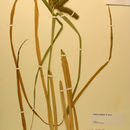Description
provided by eFloras
Plants densely to loosely cespitose; rhizomes short, no more than 10 cm. Culms trigonous in cross section, 50–120 cm, scabrous distally. Leaves: basal sheaths pale brown; ligules usually much longer than wide; blades mid to dark green, flat to W-shaped, 5–16 mm wide, glabrous. Inflorescences 4–35 cm; proximal bract 15–85 cm, much longer than inflorescence; proximal (2–)3–6 spikes pistillate, erect or the proximal pendent, cylindric, 12–18 mm thick; terminal staminate or, sometimes, gynaecandrous, androgynous, or mixed. Pistillate scales lanceolate-acuminate, 2.8–12 × 0.4–1 mm, all but the proximal shorter than perigynia, margins ciliate, apex tapering to long scabrous awn. Staminate scales scabrous-awned, sometimes ciliate-margined. Perigynia spreading to reflexed when mature, strongly 14–22-veined, most veins separated by less than 2 times their width, confluent at or proximal to mid beak, tightly investing achene, narrowly elliptic to lanceolate, (4.8–)6.2–8.7 × 1.1–1.8 mm, leathery, apex gradually tapered; beak poorly defined, 2–3.8 mm, bidentate, teeth outcurved, 1.3–2.1(–2.8) mm. Stigmas 3. Achenes pale brown, trigonous, smooth.
- license
- cc-by-nc-sa-3.0
- copyright
- Missouri Botanical Garden, 4344 Shaw Boulevard, St. Louis, MO, 63110 USA
Distribution
provided by eFloras
Ont., Que.; Ark., Calif., Conn., Del., Idaho, Ill., Ind., Iowa, Maine, Md., Mass., Mich., Minn., Miss., N.J., N.Y., N.C, Ohio, Pa., S.C., Tenn., Tex., Vt., Va., Wis.; Mexico.
- license
- cc-by-nc-sa-3.0
- copyright
- Missouri Botanical Garden, 4344 Shaw Boulevard, St. Louis, MO, 63110 USA
Habitat
provided by eFloras
Swamps and wet thickets, stream, pond, and lakeshores, depressions in wet meadows, marshes, including freshwater tidal marshes; often in shallow water or on emergent stumps, floating logs, and floating mats of vegetation; 0–700m.
- license
- cc-by-nc-sa-3.0
- copyright
- Missouri Botanical Garden, 4344 Shaw Boulevard, St. Louis, MO, 63110 USA
Comprehensive Description
provided by North American Flora
Carex comosa Boott, Trans. Linn. Soc. 20: 117. 1846
Carex furcata Ell. Bot. S. C. & Ga. 2: 552. 1824. (Type from South Carolina.) Not C. furcata
Lapeyr, 1813. "Carex Pseudo-Cyperus L." Schw. & Torr. Ann. Lye. N. Y. 1 : 355. 1826. Carex Pseudo-Cyperus var. comosa Boott, 111. Carex 141. 1867. (Based on C. comosa Boott.) Carex Pseudo-Cyperus var. americana Hochst.; L. H. Bailey, Mem. Torrey Club 1 : 54. 1889. (Type
from eastern United States.) Carex Pseudo-Cyperus var. furcata Kiikenth.; Kneucker, Allg. Bot. Zeits. 7: 195. 1901. (Based on
C. furcata Ell.)
Densely cespitose in large clumps, from short stout rootstocks, not stoloniferous, the culms stout, 5-15 dm. high, erect, usually exceeded by the upper leaves, phyllopodic, narrowly winged-triangular and from smooth to strongly roughened above, light-brownish-tinged at base, the dried-up leaves of the previous year conspicuous; leaves with well-developed blades usually 5-10 to a fertile culm, very strongly septate-nodulose, the lower clustered, the upper scattered, the blades light-green or yellowish-green, firm, flat with revolute margins, usually 2-3 dm. long, 6-16 mm. wide, long-attenuate and strongly roughened especially toward apex, the sheaths thin and hyaline ventrally, somewhat yellowish-tinged, deeply concave at mouth, the ligule very conspicuous, much longer than wide ; staminate spike solitary, short-peduncled, erect, linear, 3-7 cm. long, 4-7 mm. wide, the scales oblanceolate, ciliate, strongly rough-awned, reddish-brown with 3-nerved greenish or straw-colored center; pistillate spikes 3-6, approximate or the lower slightly separate, the lower strongly peduncled and more or less strongly nodding, the upper on short peduncles and little nodding or erect, the peduncles slender, rough, the spikes oblong-cylindric, 1.5-7.5 cm. long, 12-17 mm. wide, very densely flowered, containing very numerous reflexed perigynia in many rows; lower bracts leaf -like, little sheathing, exceeding inflorescence, the upper somewhat reduced ; scales with small ovate to narrowly lanceolate bodies ciliate-serrulate above, reddish-brown with 3-nerved green center excurrent as a long rough awn, the bodies much narrower and several times shorter than the perigynia ; perigynia lanceolate, 5-7 mm. long, 1.5 mm. wide, flattened-triangular in cross-section, scarcely inflated, smooth, shining, coriaceous, puncticulate, light-green or yellowish-green, strongly ribbed, round-tapering at base, very obliquely stipitate, tapering into a smooth, very deeply bidentate beak about 1.5-2 mm. long, the awns stiff, recurved-spreading, 1.25-2 mm. long; achenes oblong-ovoid or obovoid, 1.75 mm. long, 0.75 mm. wide, closely enveloped below, triangular with blunt angles, brownish, granular, sessile, or nearly so, tapering at apex and continuous with the slender, flexuous, persistent style; stigmas 3, slender, short, light-brownish.
Type locality: "Hab. In Georgia et Carolina, Elliott; Ohio, Sullivant; Philadelphia et Utica, Torrey; Boston, Boott.''
Distribution: Swamps, non-acid soils, Quebec to Minnesota, and southward to Florida and Louisiana; very locally on the Pacific coast from San Francisco Bay to Washington, and eastward along the larger rivers to Idaho. (Specimens examined from Quebec, Maine, New Hampshire, Vermont, Massachusetts, Rhode Island, Connecticut, New York, Nevv Jersey. Pennsylvania. Delaware, Maryland, District of Columbia, Virginia, North Carolina, South Carolina, Georgia, Florida, Louisiana. Ontario, Ohio, Michigan, Indiana, Kentucky, Wisconsin, Minnesota, Iowa, Missouri, Nebraska, Idaho, Washington, Oregon, California.)
- bibliographic citation
- Kenneth Kent Mackenzie. 1935. (POALES); CYPERACEAE; CARICEAE. North American flora. vol 18(7). New York Botanical Garden, New York, NY

